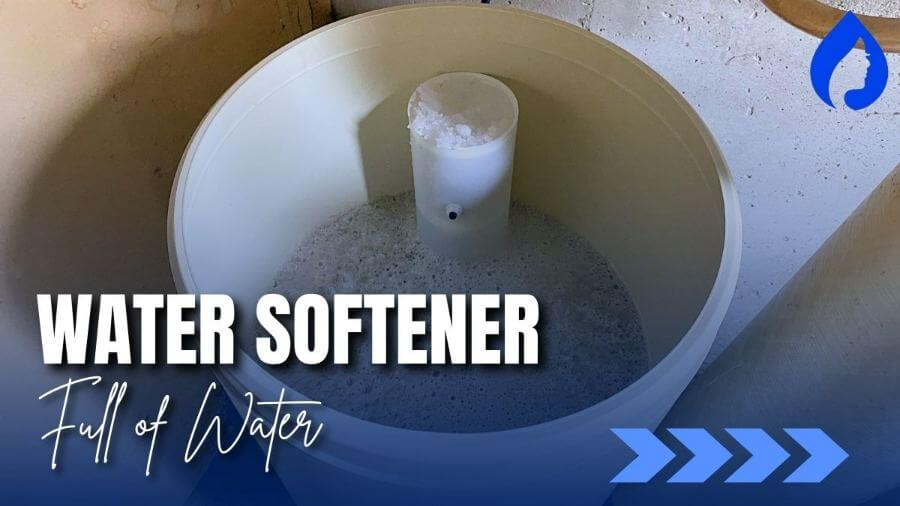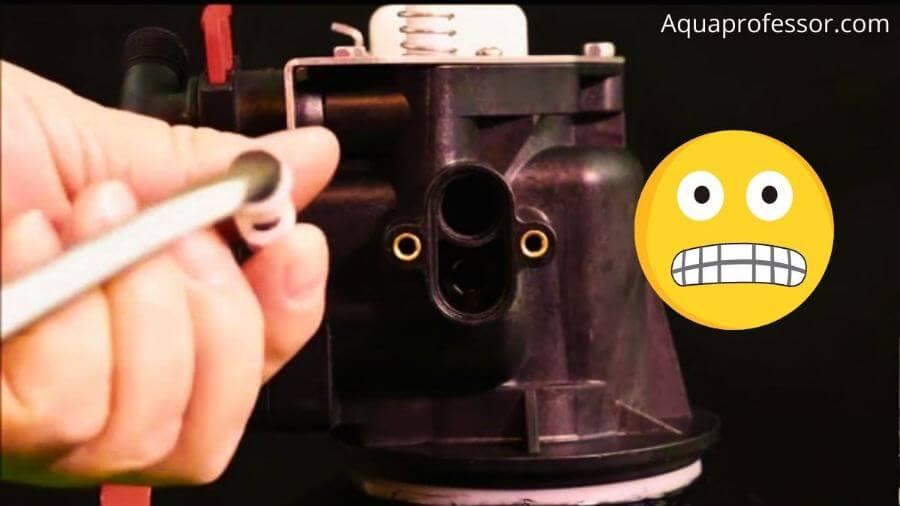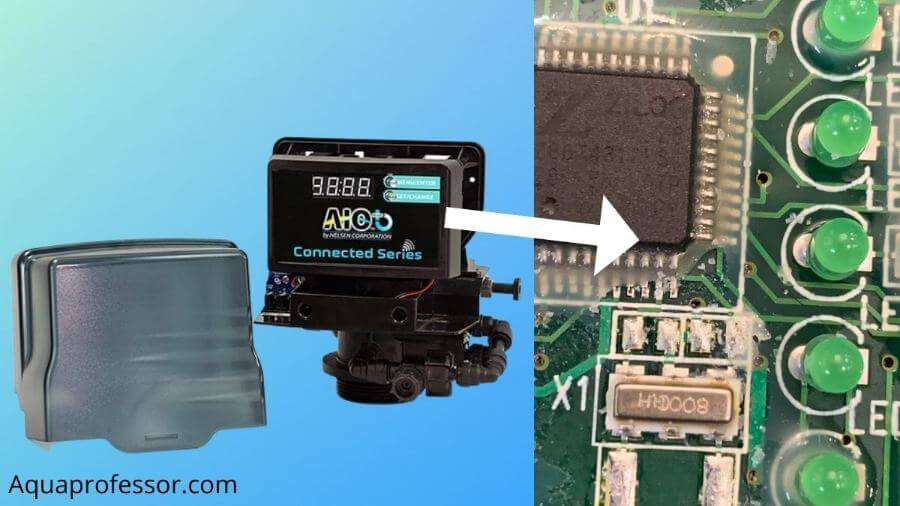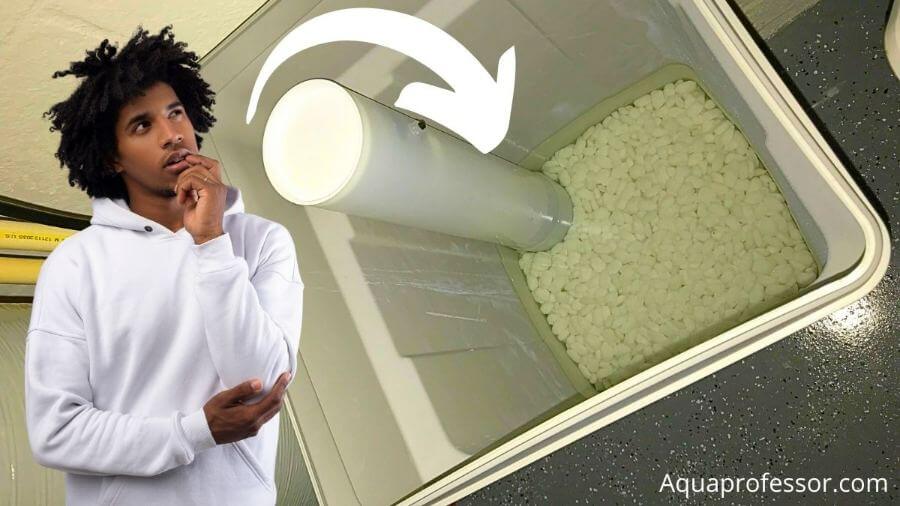
Do you find your water softener full of water and overflowing?
A clogged or blocked brine line or drain can prevent the brine tank from emptying during the regeneration cycle, causing the overflow.
To troubleshoot this, try a regen and check the brine line for clogging.
Continue reading for detailed troubleshooting on the water softener full of water for all possible reasons.
🤔What Does It Mean If Your Water Softener Is Full Of Water [Fixed!]
| Reason (arranged in order of how commonly they occur) | Troubleshooting |
| Injector Is Clogged | Perform manual regen and clean injector screen and injector. |
| Kinked Brine Drain | Straighten or replace the brine drain hose. |
| Salt clogging at the bottom of the tank | Break up the salt bridge or salt mushing with a broom handle or a tool. |
| Malfunctioning/Improperly Installed Safety Float | Adjust or replace the safety float assembly. |
| Disconnected Brine Line | Reconnect or replace the brine line tubing. |
| Backwash Flow Controller is clogged | Remove and clean the backwash flow controller. |
| Brine Line Flow Control Blockage | Remove and clean brine line flow control. |
| Circuit Board Malfunctioning | Reset or replace the circuit board. |
| Leak in softener valve seals | Replace valve seals or the entire valve assembly. |
| Damaged piston assembly | Replace piston assembly or entire valve assembly. |
Also Read: Common Water Softener Problems
💉Reason #1: Injector Is Clogged

The water softener injector is crucial for drawing brine from the brine tank during regeneration. However, when clogged with dirt, debris, or salt crystals, it loses its suction power, leaving brine stagnant in the water softener brine tank.
Fear not, as resolving this issue is simpler than you might think. Just follow these steps:
Solution
Also Read: How To Reset Water Softener
🪠Reason #2: Kinked Brine Drain
A kinked brine drain line can restrict the water flow from the water softener brine tank, leading to brine tank overflow. In addition, this drain line can malfunction if the brine tank’s overflow hose gets bent or twisted, impeding proper drainage. Drain line flow control is essential for regulating the amount of water in your system.
We can fix this issue by following these steps:
Solution
🧂Reason #3: Salt Clogging at the Bottom of the Tank
Overflowing of the softener’s brine tank can occur when salt within the tank forms a hardened crust or sludge due to high humidity, low-quality salt, or infrequent regenerations. These blockages restrict the flow of brine and water. However, you can resolve this issue by following these steps:
Solution
Also Read: What to Do If Your Water Softener Is Leaking?
🛟Reason #4: Malfunctioning/Improperly Installed Safety Float

The safety float in the water softener’s brine tank prevents water softener overflow. However, if it malfunctions (due to improper installation or otherwise), it can fail to shut off the water supply when the tank reaches its maximum capacity, resulting in continuous water filling and overflow.
We can fix this issue by following these steps:
Solution
Also Read: Water Softener Constantly Draining
❌Reason #5: Disconnected Brine Line
If the brine line becomes disconnected or is not properly attached, water can flow back into the water softener’s brine tank instead of being drawn out during regeneration. This causes the tank to fill up with water and eventually overflow, hindering the water-softening process.
Solution:
💧Reason #6: Backwash Flow Controller is clogged
During the regeneration cycle, the water softener system flushes out the accumulated hardness minerals, such as calcium and magnesium, from the resin tank.
The backwash flow controller, responsible for regulating water flow during the backwash cycle, can become clogged with dirt, debris, or salt deposits. This restriction reduces water pressure, affecting the rinsing of the resin bed and brine drainage.
But worry not; we can tackle this issue effectively by following these steps:
Solution:
Also Read: Where To Discharge Water Softener Backwash
🔗Reason #7: Brine Line Flow Control Blockage
The brine line flow control regulates brine flow into the resin tank during regeneration. Blockages caused by debris or salt can restrict the brine flow, leading to water overflow in the tank.
Solution:
💫Reason #8: Circuit Board Malfunctioning

A circuit board in a water softener controls various functions, including water intake and drainage. If the water softener’s circuit board is experiencing a malfunction or electrical issue, it can cause the softener to overfill with water, leading to a brine line malfunction.
Solution:
🚿Reason #9: Leak in Softener Valve Seals
Damaged or worn-out seals in the water softener valve can cause leaks to overflow the tank. To address this issue, follow these steps:
Solution:
🔫Reason #10: Damaged Piston Assembly
The piston assembly is a crucial component of the water softener’s valve that controls water flow and regeneration cycles. If it is damaged or not functioning properly, it can cause water to overflow from the brine tank. This issue requires immediate attention to avoid further complications.
To address this issue, follow these steps:
Solution:
Note:
If you’re unsure or uncomfortable with performing these troubleshooting steps, it’s always recommended to contact a professional technician for assistance.
🪠How To Drain Water Softener Full Of Water?

🫴Method 1: Manual Regeneration
🪣Method 2: Use a Bucket or Wet-Dry Vac
🫙Method 3: Dump Water from the Brine Tank
Note:
Consult the user manual specific to your water softener model for detailed instructions and any additional steps or precautions necessary for draining the system effectively.
💡Water Softener Full Of Water: FAQs
Should there be standing water in my water softener and brine tank?
No, standing water in the water softener and brine tank is not normal and indicates a problem with the system.
In the brine tank, it may result from improper salt dissolving due to clogs or blockages in the salt grid or injector. In the resin tank, standing water may result from backflow from the brine tank due to valve malfunctions or incorrect system setup. Follow the troubleshooting steps above to fix the problem.
Where should the water level be in a water softener tank?
The water level in your water softener tank should be a few inches below the salt level. However, this can vary depending on factors like:
Softener type- If your water softener has a dry brine tank, no water is present until the regeneration cycle starts. On the other hand, if you have a wet brine tank, it should be at least one-fourth full of water.
Softener efficiency- Efficient water softener systems require less water.
Why is my brine tank not emptying?
A brine tank may not be emptying due to issues such as clogged drain lines, malfunctioning valves, or problems with the brine tank components.
How do you fix standing water in a water softener?
To fix standing water in a water softener, you can try manual regeneration, checking and cleaning the drain lines, inspecting and repairing valve seals or float assemblies, or seeking assistance from a professional technician.
How do you unclog a brine tank?
To unclog a brine tank, you can clean the brine line flow control, remove any salt bridges or debris from the tank, or use a mild cleaning solution to dissolve mineral deposits. If the issue persists, consult a professional.

Naina has a profound understanding of how water quality affects our overall well-being. Her expertise is a guiding light for those seeking to live a healthy life. Besides raising awareness, her write-ups provide practical advice on identifying and mitigating water-related issues.
